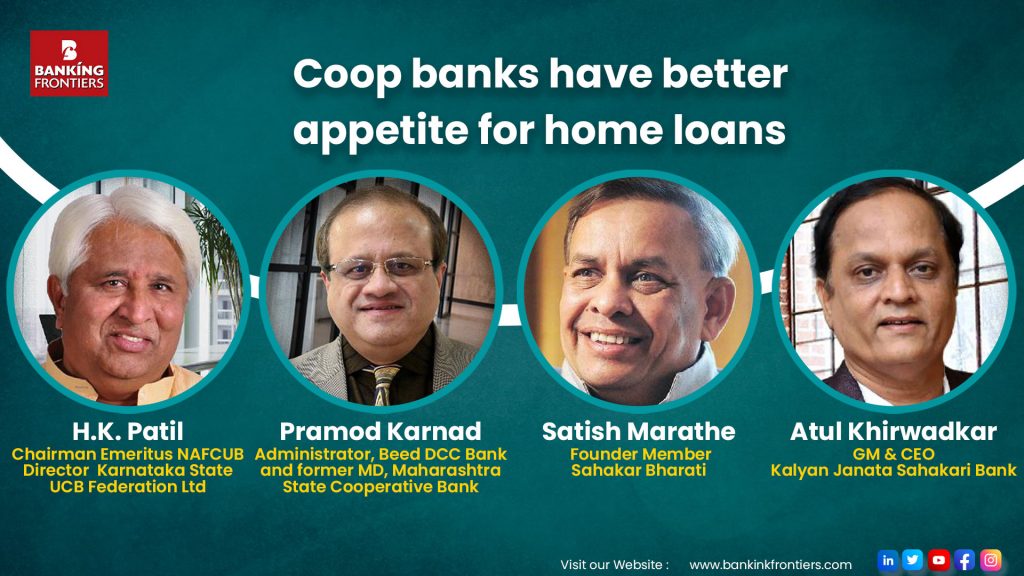The cooperative veterans welcome the RBI announcements but feel that additional considerations on a number of issues by RBI are still needed:

RBI Governor Shaktikanta Das has recently announced policy decisions that considering the importance of cooperative banks in promoting inclusive growth, 3 measures are being taken for the cooperative banking sector: (i) The limits for individual housing loans for Urban Cooperative Banks (UCBs), Rural Cooperative Banks, State Cooperative Banks (StCBs) and District Central Cooperative Banks (DCCBs) are being revised upwards by over 100% taking into account increase in house prices. (ii) In line with the dispensation available to Scheduled Commercial Banks (SCBs) and UCBs, StCBs and DCCBs will be allowed to extend finance to residential housing, within the existing aggregate housing finance limit of 5% of their total assets. (iii) UCBs can extend doorstep banking services to their customers, which will especially be of help for senior citizens and differently abled.
Veterans from the cooperative banking sector H.K. Patil, Chairman Emeritus, NAFCUB & Director, Karnataka State Urban Cooperative Banks Federation; Pramod Karnad, Administrator, Beed DCC Bank and former MD, Maharashtra State Cooperative Bank and Atul Khirwadkar, GM & CEO, Kalyan Janata Sahakari Bank, reveal their well-studied views on RBI’s said decisions and present their long-term vision about the future of the cooperative banks:
Mehul Dani: How do you view RBI permitting UCBs, StCBs & DCCBs to extend enhanced housing loans to individuals?

H.K. Patil: The increase in housing loan (HL) limits for UCBs was long overdue in view of the steady increase in cost of small houses and flats even in tier 2 and tier 3 towns across the country over the years.
Pramod Karnad: Its pleasant surprise by RBI that housing loan limits have been enhanced. It was really a need of hour as the home prices have gone up with ready reckoner rate going up. UCBs at least had good home loan limits. But the State Cooperative Bank, where I worked as Managing Director had tiny home loan limit of Rs3 million when the bank had asset size of more than Rs300 billion (it is more now) and when it is Mumbai based bank, where you won’t get a single room in Rs3 mn. So, Thank you RBI for enhanced home loan limits.
Atul Khirwadkar: RBI’s decision is a welcome step indeed. However, this is too late in the day, as the UCB sector was demanding an enhancement in these limits for almost 2 decades. When the reality sector was booming, UCBs needed these considerations. None the less, better late than never. I consider that the announcement is partially good, as I feel additional considerations by RBI are still needed.
The most significant part is that the limit has been increased by almost 100%. Given the concentration risk circular of RBI, where UCBs are required to reduce their exposure within the norms prescribed, the new guideline says that 50% of the credit portfolio should be below 0.2% of tier 1 capital for a UCB. The restriction is to ensure that the contagion of real estate sector risk doesn’t spread in the sector. As a result, even if the HL limits are enhanced, UCBs need to be careful before jumping with joy.
Further the basis of expert committee guidelines, RBI is contemplating urging the UCBs to move towards the SFBs segment without saying so much on the entire matter. For bigger UCBs this is certainly advantageous but for small banks not much can be gained unless the concentration risk circular is reviewed and revised.
Do you feel portfolio of housing loan to individuals need to be classified differently? Please explain.
H.K. Patil: Yes. The sector has long been demanding separate limits and sub limits for individual housing and commercial real estate (RE) advances. RBI has still not acceded to the demand.
Pramod Karnad: Yes, now risk weightage up to Rs3 mn is less for home loans at 50% if margin is 25% and above this its 100%. I feel that entire HL, being a priority sector, should be classified differently, has same risk weightage at 50%.
Atul Khirwadkar: RBI traditionally treats that HL should be a part of CRE exposure, where there is a restriction of 15% cap vis a vis total assets/advances. There is a need to revisit this upper limit in a different as well as practical context to boost the entire economy. I do understand that the swelling in real estate lending needs to be curbed in an appropriate fashion. On one hand, the government of India aggressively promotes ‘housing for all’, but for UCBs these restrictions are in place. If a UCB gives HL to individuals it is treated as CRE, which attracts 15% exposure, which restricts their opportunity to lend for HL. RBI needs to think of eliminating the HL exposure from the CRE and its present computation method to help banks achieve realistic growth.
Alternatively, if the risks in the real estate sector is expensive, as the regulator feels, it is quite possible to consider eliminating the exposure to affordable housing on an individual basis. Small HL up to certain amount should be excluded from the CRE exposure. This will enable the UCBs to lend aggressively because many UCBs entertain real estate lending with 200% security backup. I don’t say that having obtained the security for CRE advance is adequate. But this will improve lending with the space in CRE gap.
How should UCBs, StCBs & DCCBs draw their business growth strategy to better factor in this regulatory change in current FY?
H.K. Patil: Although the limits of individual loans have been enhanced, the overall sectoral exposure limits remain the same. Therefore, there is very little scope for impact on business growth strategies.
Pramod Karnad: Doorstep banking is good initiative and should be allowed to Financially Sound and Well Managed (FSWM) urban banks. Other UCBs need to have policy and prior approval of RBI. That’s ok, never mind but at least, comfort is given. Even average UCB can give doorstep services to old, senior citizen, handicapped people by taking prior approval of RBI, which is a welcome step. It will create competition amongst UCBs to give better services to its clientel.
Atul Khirwadkar: Needless to mention that UCBs have been reeling under the pressure of revised regulatory guidelines of late. As a result, the UCBs have virtually forgotten growth, with the exception of few large UCBs, which have wide geographical spread. Smaller UCBs are virtually between the devil and the deep sea to comply with the revised guidelines and the same time, ensure that they growth.
 RBI is taking the UCB sector back to the basics because the concentration risk guidelines restrict growth. These restrictions envisage banks to have 50% of their credit portfolio under 0.2% of the tier 1 capital on or before March 2024. This may not impact smaller banks much but will stifle growth for larger banks.
RBI is taking the UCB sector back to the basics because the concentration risk guidelines restrict growth. These restrictions envisage banks to have 50% of their credit portfolio under 0.2% of the tier 1 capital on or before March 2024. This may not impact smaller banks much but will stifle growth for larger banks.
In this situation, there is no option but to ensure exit of some large accounts and build a retail banking strategy, ie a volume game. If a bank does not have the strategy and resources to handle volume of retail credit, forget about the growth. UCBs are flushed with liquidity and the current regulatory guidelines are squeezing the liquidity in order to control the inflation. It would mean that the banks can restructure their views to have a little higher CD ratio without rise in deposits.
With increase in the advances, one may deploy the liquidity into the lending operations. But this is easier said than done. For at least 2 years, UCBs must maintain that position as also they remain in sync with the regulatory guidelines and the bottom line is maintained. To maintain the bottom line, it is necessary that rapidly changing interest rate scenario is used to the advantage of the banks. The business growth strategy can be in sync with the regulatory guidelines as also the rapid market changes. Each bank has to revise/devise its own strategy, depending upon their geographical presence and the demographics they handle.
There is a good reason to believe that the UCBs would virtually function like SFBs within norms applicable to SFBs via back door to the UCBs. The growth may be stifled in the initial period, but it will pick up, if the bank forms appropriate strategy to reach the targets.
Please provide insights as to how home loan NPAs have fared against other sectoral NPAs of cooperative banks.?
H.K. Patil: Exact statistics of NPAs of various segments of loans by UCBs are not readily available. The general perception among UCBs is that HLs give them better comfort level as they are given to members, who are well known to banks and they have tangible security to fall back. Further, the sector has better appetite for loans of longer duration like (HLs) as the banks have higher percentage of fixed deposits in their deposit portfolio.
Pramod Karnad: Private sector banks like ICICI Bank suffered for their aggressive selling of home loan product as it started turning bad. They even hired agencies to recover it by hook or crook. RBI objected to this bad method of recovery through agents. Comparatively, NPAs on HLs with cooperative banks are moderate and recoverable at its own field functionaries. HL NPAs are more easily recoverable than other sectoral NPAs since buyers / bidders are easily available. Also, the ticket size is small and people buy homes under sale by banks since it is at discount!
Atul Khirwadkar: NPS have been traditional problem for the entire banking industry. However, some of the sectors have differential exposure in terms of total gross NPAs in the industry. This year the NPAs of the industry are hovering around 6% and RBI estimates indicate that the HL segment is the lowest defaulting sector. It’s necessary for the UCBs to understand that the HL is one of the safest indicators of a healthy lending for the simple reason that the default rate is in the range of 1%. That means it is necessary for the banks to push their lending to retail housing segment, so as to contribute towards the growth in the real estate sector as also in the economy.
The government’s objective is to reach home for all by 2026 and this will be a small contribution with the reason that the default rate or the loss given default (LGD) in India in this sector is very low because maximum landing is to the needy persons and middle & lower class population, which is very sincere about the liquidation of their regular EMIs. Keeping that in mind and keeping the lowest possible NPS in this particular sector, sector is poised for boom in the coming months.
How do you rate risk management practices of coop banks juxtaposed with those of PSBs, private banks, HFCs?
H.K. Patil: Till now the risk management in UCBs has been mostly based on the familiarity of borrowers with bank. However, with RBI emphasizing on putting in place systems and practices that are prevalent in commercial banks, UCBs are learning them.
Pramod Karnad: Risk management at PSU / private sector banks is robust. They have professional people in the risk management department, headed by qualified CRO. We must admit that cooperative banks don’t have such robust risk management system to gauge parameters like risk-adjusted return on capital (RAROC). Cooperative banks need to improve it inhouse rather than depending entirely on credit bureau or risk rating agencies.
Atul Khirwadkar: UCBs have been managing risk traditionally without having any formal documentation in this area of control. As per the RBI’s ‘Trends and Progress Report’, risk management in PSU banks are much better than the cooperative banks. Despite this the cooperative banks being local ones, have been using traditional risk management methods. Given the changes in banking regulation that RBI is making, cooperative banks need to have a proper documentation on systems and procedures as risk management skills.
UCBs do not have standardized risk management practices. Fortunately, the bigger UCBs have already started or activated risk and compliance departments, with the appointment of chief risk officer. As of now, cooperative banks are reluctant to move towards risk management because that requires R&D within the banks. But these banks can borrow the system which commercial banks have been following for years.
What needs to be improved organizationally by coop banks, especially with regard to big ticket size home loans?
H.K. Patil: In view of the limits imposed even with enhancement, there is really no issue of big-ticket HLs by UCBs.
Pramod Karnad: Big ticket or small ticket size, risk is same for all loans and you need to take precautions right from the beginning of HL disbursements to avoid its ‘quick mortality’ and so on, so forth. Post credit monitoring is must and should be effective.
Atul Khirwadkar: The organisational changes must properly take care of every high-ticket loan. Smaller UCBs may not even dream to touch the upper limit of Rs14 mn given by RBI for the simple reason that they have a problem of asset liability mismatch. Almost 70% of UCBs’ term deposits are maturing within a period of one year. Technically, they have a huge asset-liability mismatch crisis and almost every bank is trying to improve this particular gap.
The leverages currently available in the regulatory guidelines for asset liability mismatch are helping them to lend to the housing sector on a miniscule basis, for the simple reason that if they pick up, the big-ticket HLs will create a huge asset liability mismatch problem. The second issue is appraisal skills for higher loan amounts, because these would typically be from business class clients and that’s where the integrity, loyalty and assessment capabilities are required to be more careful than the regular salary-based HLs. The upper limit of loan of Rs14 mn property will support a few large sized UCBs, which are hardly 30-40 in the country. Rest of the smaller UCBs should set their own limits as per their risk appetite, otherwise they will go for a disaster in future, because it is very difficult to evict a person from his home and recover the money.
Houses are priced between Rs9 mn to Rs15 mn in the metropolitan areas, hence increase in the limit is justified. But for a large part of the country increase in the limit is not justified and banks in these non-metro areas need not straight away pickup such limits. If they try to chase the big-ticket loans, they will ignore affordable housing lending opportunities. My advice is to stay away from such big-ticket loans until you must have the wherewithal to recover the loan.
How can technology be better used by coop banks with regard to increasing better housing credit flow now onwards?
H.K. Patil: Technology improves the banking function in all aspects. Even municipal authorities in most parts of the country have digitalised their land records. All these simplify and make sanctioning as well as monitoring HLs that much easier and effective.
Pramod Karnad: Surely technology helps banks to increase its credit flow. Banks need to create a database and prudent follow up system to identify potential credit taker for home loan. Technology will help banks to peep in the housing projects by builders & developers. Banks can reach virtually to prospective loanee by email or other means. Government schemes for housing, lottery, etc, can be known online and by virtue of technology, banks can reach in fraction of seconds to buyer of property for home loan.
Atul Khirwadkar: There is no option but to use technology if at all you have to do business with volumes. Lending via technology by UCBs is currently in developing stage for the simple reason that software vendors have developed the loan origination system, which is not yet stabilized.
Read More




